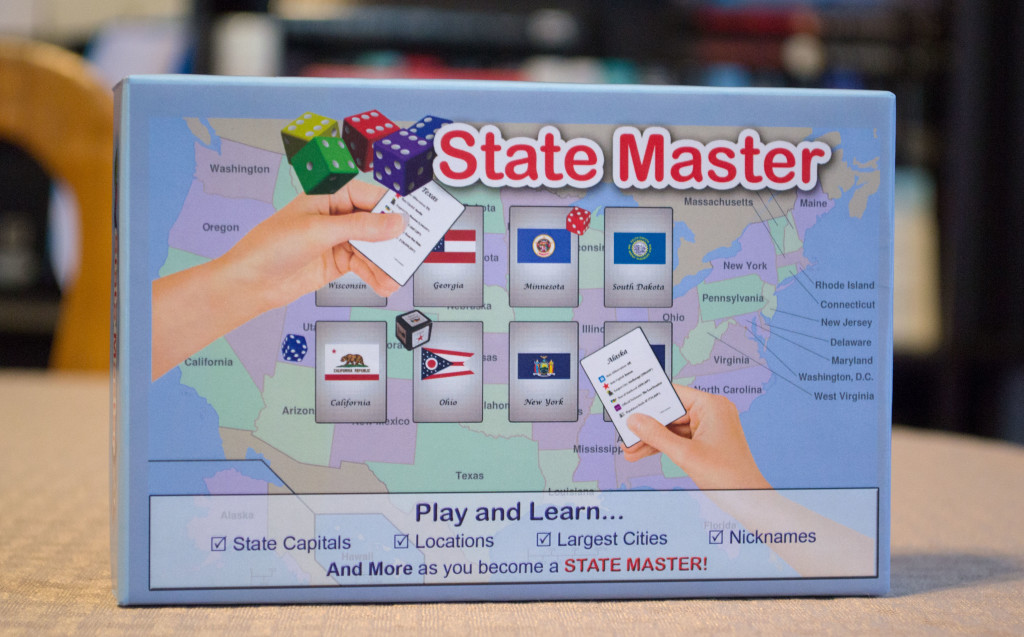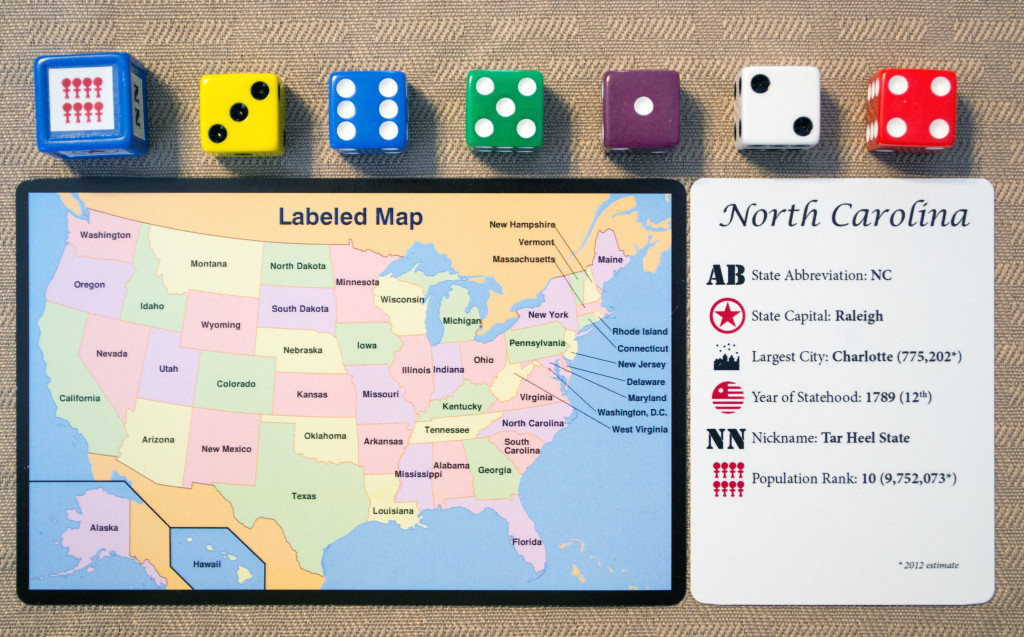Pythagorean theorem? Check. The atomic number of Carbon? Check. The correct use of “their”, “there”, and “they’re” in a sentence? Check. The capital of South Dakota? Ummmm…let me get back to you on that. As well as I did in school (proud honor student), there were always a few things that I just couldn’t grasp: geography, the lunch menu, and why “The Custom House” in Nathaniel Hawthorne’s “The Scarlet Letter” was necessary. I can’t help you on the latter two, but “State Master“, a game currently seeking your support on Kickstarter, might just be able to help with the geography bit. In short, it’s a family-friendly card game that will help teach players about the fifty US states. Before we get started, I’d like to thank Nat Dunn, the founder of Homeschool Games, for reaching out and providing me with a prototype copy. It’s important to stress that prototypes are not often reflective of the final components, making everything featured below subject to change.
My prototype copy from “The Game Crafter” included fifty state cards, six colored dice, one category die, and one map card. Despite being prototype components, I enjoyed the art and overall theme. As you may have already deduced, each of the fifty state cards represents a single US state. One side of the card lists the name of the state along with its flag, while the other side lists more detailed information about said state. The six colored dice each have a unique color and serve as player identifiers. The category dice determines what specific data that players will be tasked with getting right on any given round. The map card is two-sided as well…one side is simply a blank outline of the US while the other is a filled map of the US. The function of these components may not be readily apparent at first, but after a round or two, you’ll quickly see how they all fit together.
Setting up the game proved simple in that each player picks a colored die to call their own, then someone shuffles the state deck so that the cards are flag side up. Once that’s done, five state cards are dealt (again, face side up) onto the table for each player in the game. If two players are playing, for example, then ten state cards would be dealt flag side up onto the center of the table. The category die and map card (blank side up) are placed nearby within easy reach of all of the players. Before the game begins, someone will need to be chosen as the starting player, which can be done via a die roll. The objective of the game is to collect as many state cards as you can, as the person with the most at game’s end will be designated as the winner.
The game is played over a series of rounds. On any given round, the starting player (determined via die roll) will place their colored die onto one of the available state cards. Each player, in clockwise order, follows suit (limit one die per state card). Once everyone has placed their die on a state, the starting player will roll the category die to see which state fact they’ll need to answer about the state they’ve chosen. If the “Nickname” category is rolled, for example, then each player would need to call out the nickname for the state they chose. In turn, players will attempt to answer correctly and then look at the reverse side of the state card to see if they were right. Those who are must attempt to locate their state on the blank side of the map card.
Those who can guess both the category question correctly AND locate their state on the map wins that state card and gets their colored die back. In this case, the state card is simply placed into a score pile in front of the player. Those who don’t answer correctly will simply take their colored die back, leaving the state card in the center of the table. However, these players will have a leg up next round, having just looked at the answer/reverse side of the state card they chose. At this point, the round ends and the next starting player starts a new round. This continues until there are less state cards in the middle of the table than players, in which case the game ends. Whoever has the most state cards in their score pile, wins!
I’ll be honest here…”State Master” is a superb idea! It covers a LOT of information yet somehow extremely easy to get into and play. While I remember how helpful flash cards were in grade school, I can’t help but wonder how much more fun we could have had playing something similar to this. Flash cards have a tendency to be dull and repetitive…”State Master”, on the other hand, keeps things fresh and engaging. Each game promises to be different, what with the category die being rolled every round and the fact that only some states will make it into a single game. Speaking of categories, I liked how more than just the state’s capital is covered. Abbreviations, capitals, largest city, year of statehood, nickname, and population rank, to name them all. In addition to that, players will be challenged with finding the physical location of these states on the blank side of the map card.
Fun, easy to play, and educational, “State Master” is the epitome of what types of tools teachers should have in their classroom. I never thought I’d have fun learning about geography, but this game manages to pull it off. Well played, “State Master”, well played.
—
You can learn more about and support “State Master” by visiting its Kickstarter page, here:
https://www.kickstarter.com/projects/742137008/state-master-a-fun-and-educational-card-and-dice-g


